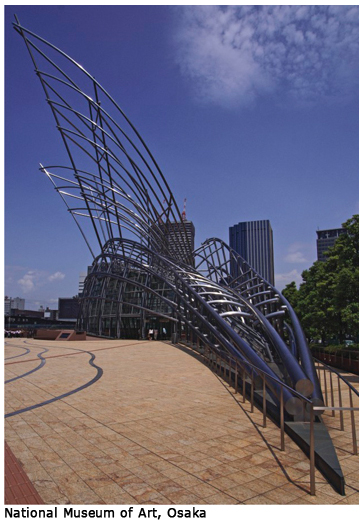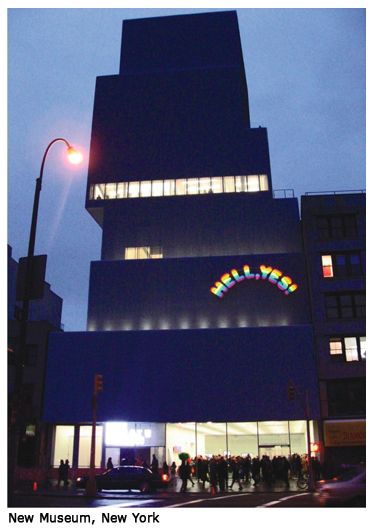Unusual Angles and Facets of Museum Buildings
Architecture
by Shambhavi R. Padukone
Unusual Angles and Facets of Museum Buildings talks about the museum building as a work of art. These buildings that often house priceless, if not prized collections, should reflect that uniqueness. Architecture is increasingly being seen as a potential tool to express the ideology and philosophy of museums. The Museum is a culturally and politically charged space, and this needs to reflect in the Building as well. The opening article of this series on unusual museum buildings provides an overview of different architectural styles that have become iconic landmarks. The subsequent articles in the series will dwell deeper into individual museums, its collection, technique of representation and the people and ideas behind the conception and construction of the architectural innovative masterpieces.
 If we look at some of the museums around the world we can find some of the most unusual and bizarre shapes and designs. These buildings seem to have come straight out of some science fiction thriller. Defiant, mysterious and wildly eccentric buildings are not always easy to love. Some have that beauty of symmetry, colour or material, but some just appear to be a jumble of mismatched structures. The development of such a trend can be traced from the conception of modern Museums, which have a long tradition of borrowing architectural forms from the past ceremonial monuments. Curators and exhibition designers have been devising new ways of representation, where they try to move away from the colonial constructs.
If we look at some of the museums around the world we can find some of the most unusual and bizarre shapes and designs. These buildings seem to have come straight out of some science fiction thriller. Defiant, mysterious and wildly eccentric buildings are not always easy to love. Some have that beauty of symmetry, colour or material, but some just appear to be a jumble of mismatched structures. The development of such a trend can be traced from the conception of modern Museums, which have a long tradition of borrowing architectural forms from the past ceremonial monuments. Curators and exhibition designers have been devising new ways of representation, where they try to move away from the colonial constructs.
The museum is a big framework where the objects take on new meaning depending on how the curator and architect wish to present them and also on the visitors' proactive engagement with the creation of new meaning and understanding. Focus has shifted from a mere collection to the individual object and it's various interpretations.. The conceptualizing and presentation of the exhibits is just one exercise. In all this, the outer structure or building that house such collections cannot be an independent entity detached from the discourse that surrounds the collection inside. Museum theories talk about the whole idea that objects in museums are not innocent and isolated. The objects get re-assessed, re-defined and re-presented in the context of their past and current location, which is the museum building.
The focus on the emerging new architectural styles seems to suggest that the design of the building is being used to reinforce the profound relationship between the past and the present (to the futuristic as well). It is being visualized as a link or a bridge between tradition and innovation where the two come together. The dramatic juxtaposing of contemporary and bold architectural forms with historical buildings or historical content acts as a reassurance or rather the reinforcement of the urban significance of the Museum. This approach to architecture is also being used as a method to resolve to a large extent the complex practical issues of exhibition, programmes and other related facilities.
 The façade becomes the first orientation point for the visitors. In an instant it establishes that it is a space where past meets the present and the programmes organized around the collection will further establish this notion. The addition of the Lee-Chin Crystal to the Royal Ontario Museum building provides a dramatic view of how new architecture can be fused with traditional existing buildings. This was part of the Museum's renovation and expansion project. The Crystal is composed of five interlocking, self-supporting prismatic structures that are not attached to the original building, except for the bridges that link them. Natural history and culture are the main themes of the museum. This link between the two is reinforced through interactive display technology within and the physically built space. Such architectural experiments are aimed to dispel the notion that a museum is a static institution where nature has been conquered and culture has been archived.
The façade becomes the first orientation point for the visitors. In an instant it establishes that it is a space where past meets the present and the programmes organized around the collection will further establish this notion. The addition of the Lee-Chin Crystal to the Royal Ontario Museum building provides a dramatic view of how new architecture can be fused with traditional existing buildings. This was part of the Museum's renovation and expansion project. The Crystal is composed of five interlocking, self-supporting prismatic structures that are not attached to the original building, except for the bridges that link them. Natural history and culture are the main themes of the museum. This link between the two is reinforced through interactive display technology within and the physically built space. Such architectural experiments are aimed to dispel the notion that a museum is a static institution where nature has been conquered and culture has been archived.
 It is not always about linking and bridging two worlds. It is also about making a statement and creating a great public spectacle. The idea of creating buildings is also to successfully interact with their contexts and the activities they contain. It should exude a 'sense of fullness and experiential richness', as quoted from the jury citation by Pritzker Prize jury chairman, The Lord Palumbo while awarding the 2010 Pritzker Architecture Prize to Kazuyo Sejima and Ryue Nishizawa (architects of the New Museum, New York). The New Museum envisions itself as a space for new art and new ideas. It has gathered a reputation of adventurousness and global scope of its curatorial program. This notion is reflected in the New Museum building as well. It is a cutting edge design that is simultaneously powerful and delicate, extremely precise and yet has a very fluid character/nature that physically can best be described as a sculptural stack of rectangular boxes dynamically placed off-axis around a central steel core.
It is not always about linking and bridging two worlds. It is also about making a statement and creating a great public spectacle. The idea of creating buildings is also to successfully interact with their contexts and the activities they contain. It should exude a 'sense of fullness and experiential richness', as quoted from the jury citation by Pritzker Prize jury chairman, The Lord Palumbo while awarding the 2010 Pritzker Architecture Prize to Kazuyo Sejima and Ryue Nishizawa (architects of the New Museum, New York). The New Museum envisions itself as a space for new art and new ideas. It has gathered a reputation of adventurousness and global scope of its curatorial program. This notion is reflected in the New Museum building as well. It is a cutting edge design that is simultaneously powerful and delicate, extremely precise and yet has a very fluid character/nature that physically can best be described as a sculptural stack of rectangular boxes dynamically placed off-axis around a central steel core.
Buildings are mostly about creating an experience. It strives to detach you from the mundane world around and pull you into a hyper-real space. Hyper-reality is a means to distinguish the way one defines what is actually "real" in a world where a multitude of media can radically shape and filter an original event or experience. However, museums are considered to present the “truth” to large extent. Perhaps that's where the fallacy lies. Museums represent and interpret the world as authentically as possible yet it is still only representative of one of the many possibilities. From the fantastic, awe inspiring to the ridiculous building designs, it all creates an experience bubble..
 Experimentation with architectural forms that reflects an identity, ideas or a way of thought is just gaining momentum. In the Indian context, museums to a large extent continue to be object-centric. Museums have not been able to use architecture as a powerful visual devise. It is designers and architects of some the religious and commercial buildings that have realized that architectural splendour speaks volumes in enhancing their own image. With new technology and the need to catch the attention and imagination of the public in a world driven by commercialism, museums all over need to devise new ways to increase public appeal. However, what this trend also suggests is that the experience of art should be more intimate, meaningful and unique.No one design would satisfy everyone. But why expect that it should? Any design would have multiple interpretations. There will be different reasons or concepts behind the design of museum buildings but all put together they create a kaleidoscopic montage of urban impressions.
Experimentation with architectural forms that reflects an identity, ideas or a way of thought is just gaining momentum. In the Indian context, museums to a large extent continue to be object-centric. Museums have not been able to use architecture as a powerful visual devise. It is designers and architects of some the religious and commercial buildings that have realized that architectural splendour speaks volumes in enhancing their own image. With new technology and the need to catch the attention and imagination of the public in a world driven by commercialism, museums all over need to devise new ways to increase public appeal. However, what this trend also suggests is that the experience of art should be more intimate, meaningful and unique.No one design would satisfy everyone. But why expect that it should? Any design would have multiple interpretations. There will be different reasons or concepts behind the design of museum buildings but all put together they create a kaleidoscopic montage of urban impressions.
The idea is simple, says Jean Nouvel, the established system doesn't work, let's invent a new one.
Tags: art, architecture






